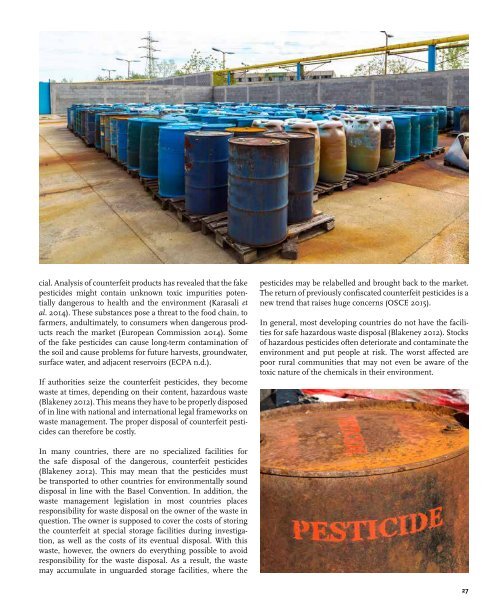WASTE CRIME – WASTE RISKS
6VhhXcA80
6VhhXcA80
You also want an ePaper? Increase the reach of your titles
YUMPU automatically turns print PDFs into web optimized ePapers that Google loves.
cial. Analysis of counterfeit products has revealed that the fake<br />
pesticides might contain unknown toxic impurities potentially<br />
dangerous to health and the environment (Karasali et<br />
al. 2014). These substances pose a threat to the food chain, to<br />
farmers, andultimately, to consumers when dangerous products<br />
reach the market (European Commission 2014). Some<br />
of the fake pesticides can cause long-term contamination of<br />
the soil and cause problems for future harvests, groundwater,<br />
surface water, and adjacent reservoirs (ECPA n.d.).<br />
If authorities seize the counterfeit pesticides, they become<br />
waste at times, depending on their content, hazardous waste<br />
(Blakeney 2012). This means they have to be properly disposed<br />
of in line with national and international legal frameworks on<br />
waste management. The proper disposal of counterfeit pesticides<br />
can therefore be costly.<br />
pesticides may be relabelled and brought back to the market.<br />
The return of previously confiscated counterfeit pesticides is a<br />
new trend that raises huge concerns (OSCE 2015).<br />
In general, most developing countries do not have the facilities<br />
for safe hazardous waste disposal (Blakeney 2012). Stocks<br />
of hazardous pesticides often deteriorate and contaminate the<br />
environment and put people at risk. The worst affected are<br />
poor rural communities that may not even be aware of the<br />
toxic nature of the chemicals in their environment.<br />
In many countries, there are no specialized facilities for<br />
the safe disposal of the dangerous, counterfeit pesticides<br />
(Blakeney 2012). This may mean that the pesticides must<br />
be transported to other countries for environmentally sound<br />
disposal in line with the Basel Convention. In addition, the<br />
waste management legislation in most countries places<br />
responsibility for waste disposal on the owner of the waste in<br />
question. The owner is supposed to cover the costs of storing<br />
the counterfeit at special storage facilities during investigation,<br />
as well as the costs of its eventual disposal. With this<br />
waste, however, the owners do everything possible to avoid<br />
responsibility for the waste disposal. As a result, the waste<br />
may accumulate in unguarded storage facilities, where the<br />
27


